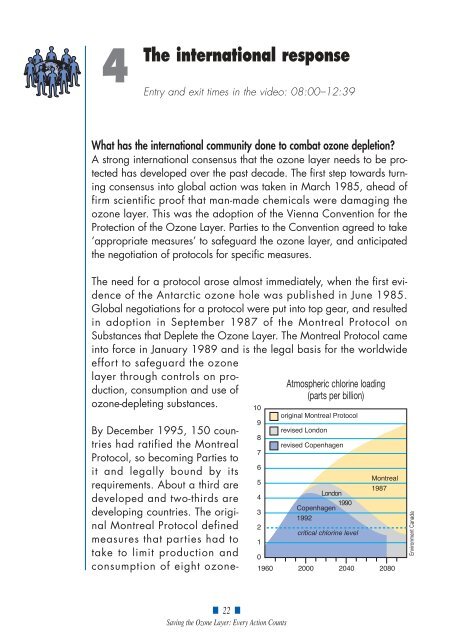Saving the Ozone Layer: Every Action Counts
Saving the Ozone Layer: Every Action Counts
Saving the Ozone Layer: Every Action Counts
Create successful ePaper yourself
Turn your PDF publications into a flip-book with our unique Google optimized e-Paper software.
4<br />
Entry<br />
The international response<br />
and exit times in <strong>the</strong> video: 08:00–12:39<br />
What has <strong>the</strong> international community done to combat ozone depletion?<br />
A strong international consensus that <strong>the</strong> ozone layer needs to be protected<br />
has developed over <strong>the</strong> past decade. The first step towards turning<br />
consensus into global action was taken in March 1985, ahead of<br />
firm scientific proof that man-made chemicals were damaging <strong>the</strong><br />
ozone layer. This was <strong>the</strong> adoption of <strong>the</strong> Vienna Convention for <strong>the</strong><br />
Protection of <strong>the</strong> <strong>Ozone</strong> <strong>Layer</strong>. Parties to <strong>the</strong> Convention agreed to take<br />
‘appropriate measures’ to safeguard <strong>the</strong> ozone layer, and anticipated<br />
<strong>the</strong> negotiation of protocols for specific measures.<br />
The need for a protocol arose almost immediately, when <strong>the</strong> first evidence<br />
of <strong>the</strong> Antarctic ozone hole was published in June 1985.<br />
Global negotiations for a protocol were put into top gear, and resulted<br />
in adoption in September 1987 of <strong>the</strong> Montreal Protocol on<br />
Substances that Deplete <strong>the</strong> <strong>Ozone</strong> <strong>Layer</strong>. The Montreal Protocol came<br />
into force in January 1989 and is <strong>the</strong> legal basis for <strong>the</strong> worldwide<br />
effort to safeguard <strong>the</strong> ozone<br />
layer through controls on production,<br />
consumption and use of<br />
ozone-depleting substances.<br />
By December 1995, 150 countries<br />
had ratified <strong>the</strong> Montreal<br />
Protocol, so becoming Parties to<br />
it and legally bound by its<br />
requirements. About a third are<br />
developed and two-thirds are<br />
developing countries. The original<br />
Montreal Protocol defined<br />
measures that parties had to<br />
take to limit production and<br />
consumption of eight ozone-<br />
10<br />
9<br />
8<br />
7<br />
6<br />
5<br />
4<br />
3<br />
2<br />
1<br />
0<br />
1960<br />
Atmospheric chlorine loading<br />
(parts per billion)<br />
original Montreal Protocol<br />
revised London<br />
revised Copenhagen<br />
London<br />
1990<br />
Copenhagen<br />
1992<br />
critical chlorine level<br />
Montreal<br />
1987<br />
2000 2040 2080<br />
Environment Canada<br />
■ 22 ■<br />
<strong>Saving</strong> <strong>the</strong> <strong>Ozone</strong> <strong>Layer</strong>: <strong>Every</strong> <strong>Action</strong> <strong>Counts</strong>
















